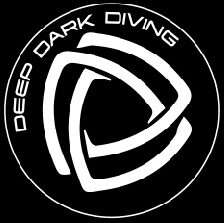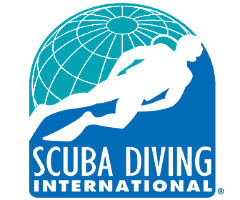Side mount rebreathers are specialized units worn on the side of the diver’s body rather than on the back. This configuration has become extremely popular with cave and technical divers, allowing for better maneuverability in tight spaces and greater comfort.
Combining a Sidemount CCR and the side mount configuration results in less resistance and drag underwater, allowing the diver to move more swiftly and gracefully through the water.
“Once a new technology rolls over you, if you’re not part of the steamroller, you’re part of the road.”
Stewart Brand, Writer
Choosing a rebreather is always challenging. When you are new to rebreather diving, you have yet to learn the most important features: you read, you ask, and you try diving different units, but you only really get the true feeling once you get the hours underwater.
After a few years of diving my Megalodon, a reliable and well-built backmount unit, I now have some important criteria for choosing my side mount rebreather. I first dived the Kiss Sidewinder, a very popular sidemount unit, simple with great Work Of Breathing, and very fun to dive. Unfortunately, it never met my expectations; I was somehow disappointed by the quality and could never quite reach the peace of mind I had while diving the Megalodon, a rock-solid unit that never let me down. Naturally, I wanted to move on to a better-built, more reliable sidemount unit with more redundancy. And the winner is the Divesoft Liberty Sidemount rebreather.
Some criteria for choosing a Sidemount CCR
Here are some key features of a Rebreather to consider to narrow down your options.
- mCCR or eCCR: mCCR with needle valve or Constant mass flow (CMF) or eCCR or eCCR that can be operated as mCCR
- Type of scrubber: axial or radial
- Scrubber duration
- Gases: onboard or offboard
- Flood Tolerant
- Work Of Breathing (WOB)
- Ability to plug offboard gases added in an emergency
- Size, Position on Body, Streamlined
- Weight of the unit for travelling and while diving
- Counterlung: type, volume, position, number, design (with or without a purge, a water trap…)
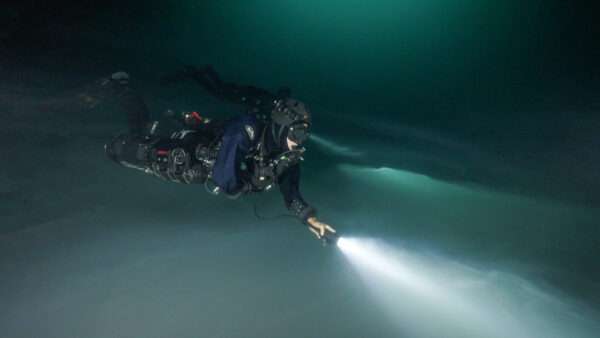
How does the Divesoft Liberty meet my criteria for a Side Mount Rebreather
- eCCR or mCCR: eCCR is the best choice for deep diving, enabling the best control of the PpO2 during the entire dive. The Liberty can also be run as a full mCCR or as eCCR with a low set point for safety, maintaining the PpO2 manually to the desired value. That makes it ideal for shallow cave diving with many depth changes and deep diving.
- Type of scrubber: radial. Radial scrubbers are known for being more efficient and last longer.
- Scrubber duration: The duration will depend on the kind of diving and water conditions. The 2.5 kg, 5.58 lb radial scrubber offers the possibility for long dives or repetitive dives.
- Gases onboard: I found offboard gases to complicate donning and doffing the unit. Having all gases onboard makes it easier to manipulate and transport. On the Liberty Sidemount CCR, the tanks are very streamlined. Minor modifications allow offboard gases, which are indispensable if one of the tanks is empty or goes through a catastrophic failure. However, the rebreather is still fully operational; it enables continuing diving the unit. (Quite important for cave diving and decompression diving) Using offboard connectors compatible with other CCR divers in the team allows for greater redundancy and more safety.
- Flood Tolerant: the unit has a water trap in the exhaust counterlung and a dump valve. This prevents water from reaching the head and the scrubber making it highly flood tolerant. The scrubber is equipped with a water trap that removes the humidity during the dive.
- Easy WOB in all positions
- Size, Position on Body, Streamlined: slightly bigger than an AL80/12L tank, the unit takes the place of a side mount tank without any modification of the sidemount setup
- Weight of the unit, lightweight, easy to carry, and light enough to travel the world!
- Counterlung: the counterlungs are on the upper side of the body, close to the lung, and don’t affect the buoyancy and trim.
- Possibility to plug offboard gases with minor modifications.
If you are wondering what side mount rebreather to choose, you will find below the technical specs of some of the units available on the market.
Our favorite: The Liberty Sidemount rebreather
The Liberty Side Mount CCR is a revolutionary piece of dive gear that allows divers to explore the depths of any dive site safely. Incorporating the latest materials, engineering, and technology innovations, the Liberty Sidemount CCR provides unmatched performance in deep-water diving. It is the perfect choice for advanced and recreational divers looking for a reliable and secure system for deep dives.
The Liberty SideMount CCR is easy to configure and streamline. The frame is self-draining and vented to avoid any buoyancy issues. The system is designed to be extremely efficient to minimize drag and maximize the divers efficiency in the water.
The weights and buoyancy of the sidemount configuration are evenly distributed across the diver’s body, providing greater stability and allowing for easier and more efficient control and great maneuverability
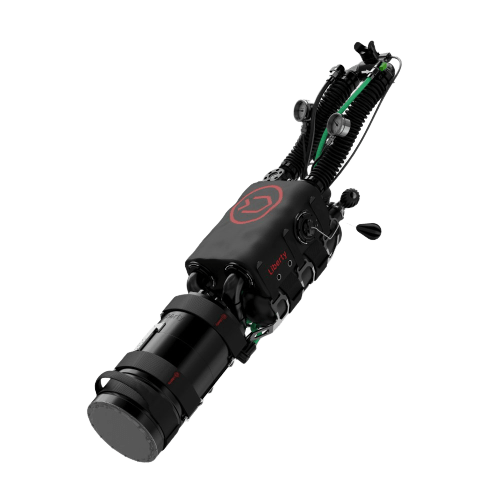
Divesoft Liberty Sidemount Rebreather
It is equipped with two handsets that clearly display important dive information and several display options to make it simple to keep track of your dive the way you choose.
The Liberty Sidemount CCR system is powered by Li-Ion batteries, which can be recharged for extended dive times.
It is suitable for both cold and warm water dives. It is certified to a depth of 150 meters, making it a viable option even for deep, technical dives. It also has a long scrubber duration, allowing you to get more dives from a single canister.
The technological advancement of this CCR enables divers to choose between a side-mounted or a back-mounted configuration.
The Liberty Sidemount CCR offers an impressive array of features and capabilities. It has been built with an integral multiple gases dive computer with Helium sensors.
For divers looking to take their diving from recreational to technical, the Liberty Sidemount CCR offers an ideal solution.
For me, the Liberty Sidemount CCR is the perfect tool for exploring any dive environment.
Technical specs of the Liberty Side mount CCR:

- Market launch: 2018
- Rebreather type (eCCR, mCCR, both): eCCR
CONTROLLER
- Electronics: Divesoft
- Redundant controller: Yes
- CCR Bail out mode: Yes
GAS
- Diluent on-board: 2L
- Oxygen on-board: 2L
- no need for off-board gas
DRY WEIGHT: 19kg (41,89 lb)
WEIGHT READY TO DIVE: 22 kg
PRICE WITHOUT OPTIONS: 9.100,00 €
SCRUBBER
- Type: radial scrubber
- Volume: 2.5 kg, 5.58 lb
- Temperature stick: No
LOOP
- Active loop volume: 5,5 L total volume
- Counterlung: (2 CLs Inhale/Exhale)
- Flood resistant: Yes + Additional water trap in the exhale counterlung to protect the oxygen sensors.
WORK OF BREATHING: Amazing due to counterlung position
SENSORS:
- Oxygen sensors: 4
- Helium sensors: 2 (optional)
- CO2 sensor: no
- Solid state sensor: no
HANDSETS: 2
BACKMOUNT CONVERSION: Yes
DISPLAYS
- Head Up Displays: Yes
- Buddy display: Yes
- Warnings: Vibration
- Near Eye computer: ODA
SIZE: Similar in size to a bailout cylinder. Ideal as a bailout rebreather.
MANUFACTURER: https://www.divesoft.com/en/products/ccr-liberty/ccr-liberty-sidemount
- The unit comes ready to dive: clip it on and go diving.
- Neutrally buoyant
- OPV valve for easy Diluent flush and water evacuation.
Other Sidemount rebreathers on the market
Some of the side mount rebreathers available on the market include (non-exhaustive, update April 2024):
Flex CCR Sidemount Rebreather
Manufactured by X-CCR, this is a compact and lightweight side mount rebreather designed for technical diving. It features a modular design that allows for easy customization and maintenance.
Flex CCR is a robust, compact exploration rebreather.
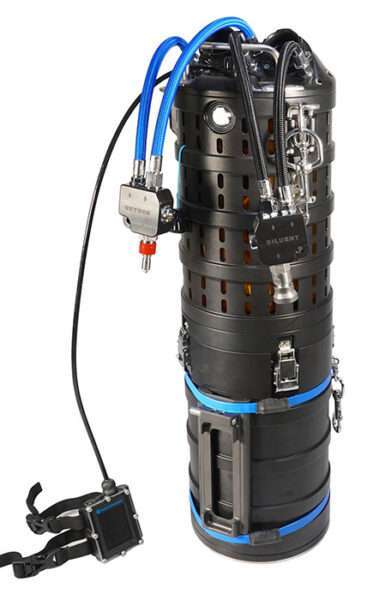
Technical specs of the FLEX2- CCR Side Mount Rebreather:
- Market launch: 2018
- Rebreather type (eCCR, mCCR, both): either mCCR with a CMF, or eCCR with a solenoid.
CONTROLLER
- Electronics: Shearwater Petrel 3
- Redundant controller: No
- CCR Bail out mode:
GAS
- Diluent on-board: 2L
- Oxygen on-board: 2L
- Offboard gas : YES, with QC6 connectors
SCRUBBER
- Type: radial scrubber
- Volume: 2.5 kg, 5.58 lb
- Temperature stick: No
LOOP
- Active loop volume: 6 L total volume
- Counterlung: two 3D counterlungs
- Flood resistant: Yes + Additional water trap in the exhale counterlung to protect the oxygen sensors.
WORK OF BREATHING:
SENSORS:
- Oxygen sensors: 3
- Helium sensors: NO
- CO2 sensor: NO
- Solid state sensor: NO
HANDSETS: 1
BACKMOUNT CONVERSION: Yes
DISPLAYS
- Head Up Displays: Yes
- Buddy display: NO
- Warnings: Vibration
- Near Eye computer: Shearwater NERD 2
DRY WEIGHT:
WEIGHT READY TO DIVE: 22 kg
SIZE: Similar in size to an 11L/AL80 cylinder
PRICE WITHOUT OPTIONS: eCCR: $6,509.00 – mCCR: $4,429.00
MANUFACTURER: https://flexccr.com/
- The unit is completely self-contained with the exception of oxygen and diluent gas supplies.
- counterlungs with dump valve and bayonet connectors with snorkels, head (incl. watertight cable connectors)
- Top Lid with ADV
- Integrated MAV ports and hose bayonets, and nipples
- Additional components and electronics packages can be added to this platform to configure the unit to your specific requirements.
Find out more: https://flexccr.com/
FX CCR Rebreather
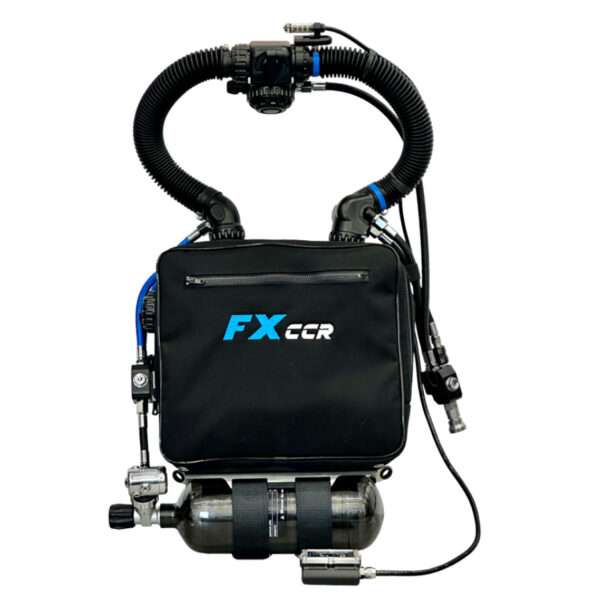
Technical specs of the FX- CCR:
- Market launch: 2023
- Rebreather type: electronically controlled unit (eCCR) with a solenoid or hCCR with Solenoid + Needle Valve O2 MAV
CONTROLLER
- Electronics: Shearwater Petrel 3
- Redundant controller: No
- CCR Bail out mode: N/A
GAS
- Diluent on-board:
- Oxygen on-board:
- Offboard gas:
SCRUBBER
- Type: radial scrubber
- Volume: 2.2 kg
- Temperature stick: No
LOOP
- Active loop volume:
- Counterlung: 7.5L Frontmounted CL
- Flood resistant: Snorkel in the exhalation CL to prevent water passage – Water trap before the scrubber
WORK OF BREATHING:
SENSORS:
- Oxygen sensors: 3
- Helium sensors: NO
- CO2 sensor: NO
- Solid state sensor: NO
HANDSETS: 1
BACKMOUNT CONVERSION: NO
DISPLAYS
- Head Up Displays: Yes
- Buddy display: NO
- Warnings: Vibration
- Near Eye computer: Shearwater NERD 2
DRY WEIGHT:
WEIGHT READY TO DIVE: 14 kg
SIZE: Similar in size to a bailout cylinder. Ideal as a bailout rebreather.
PRICE WITHOUT OPTIONS: $7,995.00
MANUFACTURER: https://ccr.sub-gravity.com/product/fx-ccr/
KISS Sidewinder Sidemount Rebreather
The KISS Sidewinder side mount rebreather has taken on the industry by storm and has proven to be one of the most popular sidemount rebreather ever.
Sidemount rebreathers have historically taken on the form factor of a sidemount open circuit tank. While this design attempts to mimic the streamlining of a sidemount cylinder, often hydrostatic work of breathing issues results if the unit isn’t perfectly rigged and mounted. Even when it is, the work of breathing is only optimal when in certain diving positions.
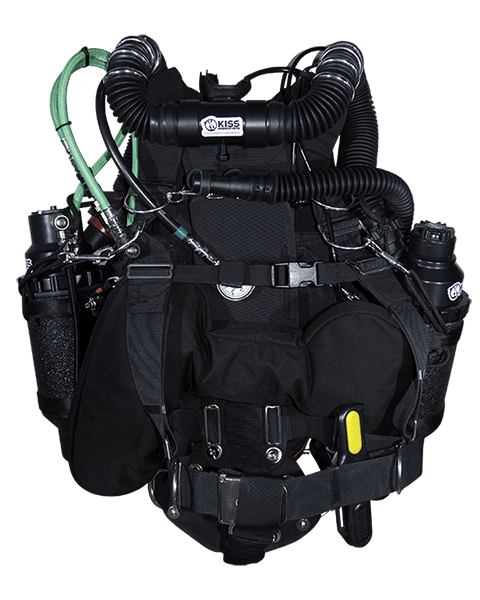
Manufactured by KISS Rebreathers, this sidemount rebreather is popular among technical divers. It features a simple, robust design that is easy to maintain.
Pros: easy to assemble and disassemble, lightweight, and customizable.
Cons: may require additional weight to achieve neutral buoyancy, and limited storage capacity.
The Sidewinder’s innovative split canister design allows for the smallest profile while maintaining perfect hydrostatic work of breathing while diving.
The KISS Sidewinder rebreather solves these issues by splitting the canisters on the diver’s left and right sides. These are connected by one 8-liter counterlung, which spans across the diver’s back. The result is a clean, streamlined configuration that provides excellent work of breathing in most diving orientations.
Technical specs of the KISS Sidewinder
- Depth rating: 300 fsw / 91 msw
- Scrubber Type: bi-axial design
- Scrubber Capacity: 4.4 lbs.
- Weight: Complete with BOV, harness and wing (minus tank and sorb) 21-lbs. / 9.5 kg
Find out more: https://www.kissrebreathers.com/
https://www.kissrebreathers.com/catalog/KISS-Sidewinder-p207591749
KISS Sidewinder2 SW2 Sidemount Rebreather – Launch Mid 2024
The KISS Sidewinder 2 CCR, anticipated eagerly by enthusiasts, features great development by KISS Training Director Patrick Widmann. This model represents an advancement from the original Sidewinder introduced seven years ago. Conceived by KISS owner Mike Young for a wounded veteran named Joshua, the Sidewinder’s unique features, including a split-scrubber design and single counterlung, earned praise for its ease of use and stability in the water, appealing to both disabled and able-bodied divers alike.
Under the new ownership of the Darkwater Group, KISS embarked on refining the Sidewinder concept, aiming for CE certification. Collaborating with Darkwater Group CEO Piotr Czernik, Patrick Widmann oversaw the redesign, maintaining the split scrubber concept while enhancing various aspects of the rebreather.
The Sidewinder 2 offers modularity, accommodating either single back mount or twin sidemount configurations with interchangeable components. Notably, the split scrubber design now features square canisters with a patent-pending “cross flow” design, offering improved cold water performance and reduced work of breathing. Enhanced sensor integration and sealing mechanisms ensure reliability and durability in challenging underwater conditions.
Improvements include the addition of a water dump in the ADV head and an adjustable automatic diluent add valve. The incorporation of a new “flush valve” for gas dump during bailout mode and a redesigned “revolver-style” two-button MAV further refine the user experience.
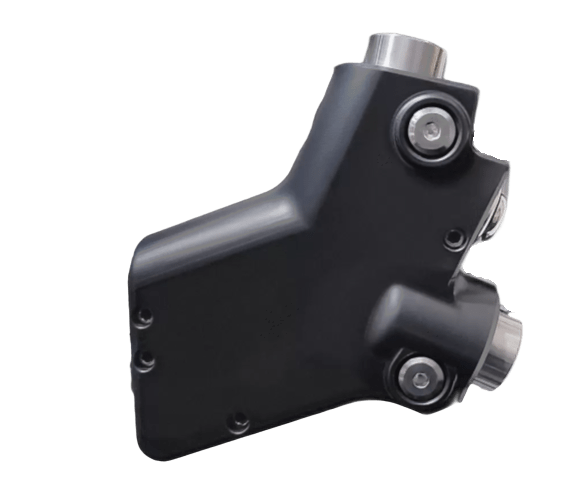
Pending CE testing, the Sidewinder 2 is scheduled for release to instructors by mid-2024 and to consumers thereafter, with an expected price range between €6K-€7K ($6472-$7551), offering an upgraded rebreather experience for diving enthusiasts.
Find out more: https://www.kissrebreathers.com/
SF2 Sidemount Rebreather
Manufactured by SF2, this Side Mount CCR is specifically designed for side mount diving. It features a compact and lightweight design ideal for cave and wreck diving.
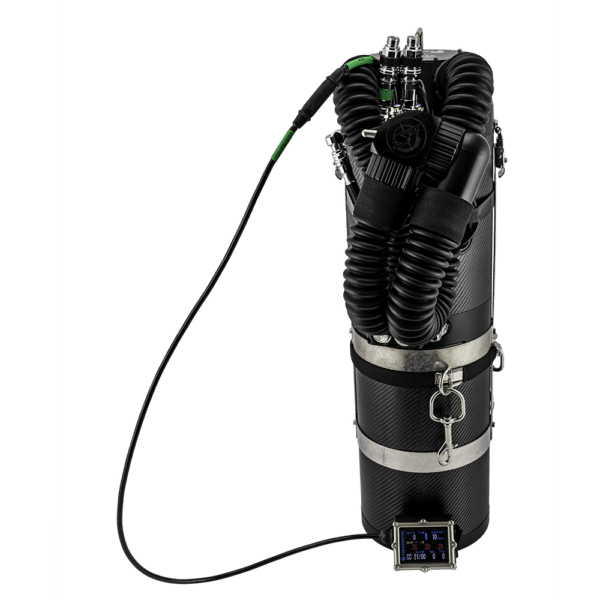
Pros: easy to travel with, user-friendly, reliable electronics.
Cons: limited customization options, relatively expensive.
The SF2 ECCR is a very popular Side mount rebreather. Its compact size, low weight, and robust structure make the SF2 Sidemount CCR a reliable tool for exploration dives.
The basic components are taken from the SF2 Backmount version. The SF2 Sidemount Rebreather has the same compact electronics chamber and inner counterlung. The upper and lower tube are constructed of a very light, yet durable carbon fiber.
Technical specs of the SF2 Side Mount CCR
- Depth rating: 100 meters (328 feet)
- Oxygen sensors: 3
- Breathing loop volume: 2 liters (1.2 liters per counterlung)
- Weight: 22 kg (48.5 lbs)
- Dimensions (without cylinders): 71cm x 52cm x 21cm (28in x 20.5in x 8in)
- Batteries: Lithium-ion rechargeable
- Scrubber: 2.2 kg (4.9 lbs) radial scrubber cartridge
Find out more: https://www.scubaforce.eu/
KISS Sidekick
As the name indicates, the KISS Sidekick is a streamlined, lightweight rebreather system designed specifically for side-mount diving applications.
This system was created in response to the needs of cave divers and explorers working in situations where back-mounted rebreathers create a hindrance to negotiating tight restrictions. In these situations, the Sidekick becomes the obvious choice as a stand-alone rebreather. Due to its compact size and mounting position, it can also be carried as a bailout rebreather (BOB) system.
The most striking feature of the Sidekick is its small size. This compact profile, combined with the unit’s simplicity of design and reliable mechanical operation, make it well suited for use as a side mount GEM SCR or CCR rebreather, bailout rebreather, or simply as an add-on gas extender, with none or very few modifications required to fill all of these roles.
Like all KISS systems, the Sidekick is a mechanical rebreather, so there are no electronics controlling the gas addition to the system. Its unique design places the head and scrubber inside a large single counterlung housed within and protected by a cylindrical-shaped stainless frame. The Scrubber head is a single chamber that holds three sensors. It is fitted with two hose attachment towers for the loop hoses, gas addition fitting(s), ADV, and an exhaust valve.
Due to the nature of the counterlung’s configuration around the scrubber, the sidekick’s in-water buoyancy is close to neutral. It becomes slightly positive (varies with diver’s tidal lung capacity) during the diver’s exhalation cycle, then slightly negative during the inhalation cycle. Because the scrubber is surrounded by the same gas coming and going to the diver, the scrubber is able to retain more warmth. This is a benefit as the temperature is an important component for the chemical reaction, and the insulation of the counterlung helps maximize CO2 extraction by the absorbent.
Like the KISS GEM SCR, the GEM Sidekick SCR uses the same patented passive-addition DSV. By shunting a portion of each exhaled breath back into the loop, this device will extend the duration of a given gas supply by a factor of three. The benefits of this type of gas-extension provide advantages for both recreational and technical diving.
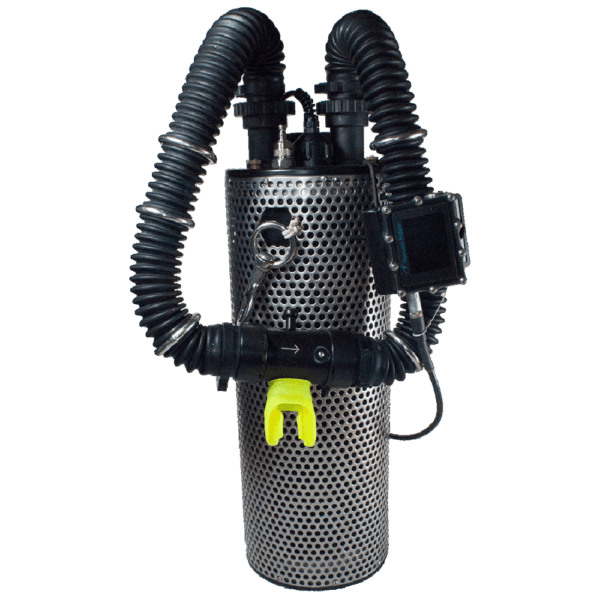
In place of the special GEM DSV needed for SCR use, the mCCR version ships with a standard closed-circuit rebreather mouthpiece (DSV). (Note: This is the only CCR model offered by KISS Rebreathers that does not include a BOV.) Other changes include the addition of a MAV (the same used in all KISS CCRs) for controlling oxygen addition to the loop.
To provide reliable, real-time PO2 monitoring, the Sidekick CCR uses the same triple oxygen cell configuration as other KISS CCR models. These cells are wired to a Fischer cable, or as an optional upgrade, can be hardwired to a Shearwater Petrel computer. This unit is compatible with Trimix.
Technical specs of the KISS SideKick
- Scrubber Capacity: 5.2 lb (2.4 kg) of Sofnolime 408 grade
- Dimensions: 21.25 inches (54 cm) long by 7.25 inches (18.4 cm) in diameter Without the loop hoses.
- Weight: fully assembled, ready to dive with full scrubber 22.2 lb (10.1 kg)/Fully assembled but without absorbent, the weight drops to 17 lbs. / 7.7 kgs.
- Gas Compatibility: Air, Nitrox, and Trimix.
- Sidekick SCR
- Mouthpiece: Special GEM DSV
- Oxygen Sensors: Requires 3 K-22D model cells, or similar models under different brand/label).
- Gas Supply Requirements: Nitrox
- Sidekick mCCR
- Mouthpiece: Standard DSV
- Oxygen Sensors: Requires 3 K-22D model cells, or a similar model under different brand/label).
- Additional hardware: MAV system for manual oxygen addition.
- Gas Supply Requirements: Oxygen and Dil
Fathom Gemini
The Gemini is the new cool kid on the block. It has immediately encountered great success. Only time and feedback from the users will tell if it matches the expectations of the divers. After the great success of the sidewinder, Fathom heard the complaints and satisfactions of the divers and got inspired to build this rebreather.
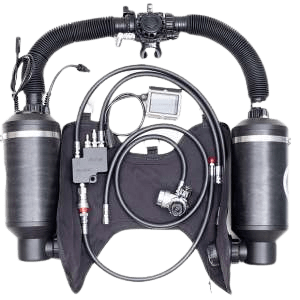
Technical Specs of the Fathom Gemini:
- Weight: 20.2 lb (9.2 kg) without cylinders or scrubber material
- No batteries inside the head, which eliminates the possibility of toxic chemicals in the breathing loop
- Splitter/isolation board allows two devices to monitor oxygen sensors
- Hardwired leads and coaxial SMB connectors on oxygen sensors eliminate multiple connections and fragile Molex connectors.
- Minimal head space reduces static loop volume
- Gas addition in exhale head ensures proper gas mixing in the scrubber before it reaches the sensors and diver
- Backmounted counterlung provides excellent work of breathing (WOB) in all positions while keeping the frontal area free of clutter for stage bottle mounting and minimizing diver’s profile.
- OPV in counterlung acts as a water dump, allowing the diver to dewater the unit if needed.
- Shrimp DSV with quick disconnect bayonets allow for easy cleaning and inspection of one-way valves
- Optional Shrimp BOV allows for a rapid bailout without removing the mouthpiece
- Scrubber: 4.8 lb (2.2 kg) dual axial scrubbers; Removable and swappable scrubber baskets
- Black Amalgon canister insulates the scrubber 400 times better than aluminum.
- Latchless head, canister, and bottom streamlines profile
- 316 SS Swagelok needle valve for precise flow: The needle valve incorporates the simplicity of a constant mass flow (CMF) orifice without the IP adjustment issues or the risk of blockage from debris.
- Fully recessed manual oxygen/diluent addition buttons prevent unwanted gas addition
- maximum depth: 400-600 fsw (122-183 msw)
- Female QC-6 plugs into offboard bailout/diluent
- NEW and improved HUD provides reliable secondary PO2 monitor
› Reversible display
› Automatic brightness adjustment
› Voltage indication on start-up
› Visual alarm feature - NEW Shearwater Petrel 3 primary display
- Optional Shearwater NERD 2 replaces Petrel 3 as a primary display
Find out more: https://www.fathomdive.com/product/fathom-gemini-ccr/
T-REB Rebreather
T-REB eCCR was designed by divers as a side mount system. Every part of the unit was worked out to give the greatest dive comfort, maximum streamlined configuration, easy attachment, and best visibility.
Single-hand oxygen, diluent, and OPV management. Light, and small controller that gives a clear view of what happens in the loop make the unit comfortable. Ready to dive, T-REB is not bigger than an 80cuf tank. This makes life easier. The unit is robust and can be used in any environment. Hard anodized surfaces are scratch-resistant in all diving conditions. The display is protected by sapphire glass.
T-REB attaches perfectly to the diver’s body and allows all positions without substantially affecting the WOB. Long head-down descends are not a problem. Head-up ascends are also easy. The underwater trim is perfect. The diver can manage the neutral buoyancy from positive to negative by changing the current loop volume.
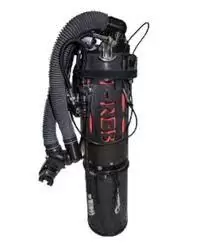
Technical specs of the T-REB Side Mount CCR:
- Market launch: 2020
- Rebreather type: eCCR
CONTROLLER
- Electronics: eCOiS (Other Gravity)
- Redundant controller: No
- CCR Bail out mode: No
GAS
- Diluent on-board: No, off board diluent Swagelock
- Oxygen on-board: 2L
- Offboard gas:
SCRUBBER
- Type: radial Scrubber
- Volume: 2.5 kg
- Temperature stick: No
LOOP
- Active loop volume: 4.6 L
- Counterlung: 2 x 3D counterlungs 2.3 L, Inhale/Exhale
- Flood resistant: Water traps in the CL
WORK OF BREATHING:
SENSORS:
- Oxygen sensors: 3
- Helium sensors: No
- CO2 sensor: No
- Solid state sensor: No
HANDSETS: 1
BACKMOUNT CONVERSION: No
DISPLAYS
- Head Up Displays: No
- Buddy Display: No
- Warnings: Visual alarm on handset
- Near Eye computer: No
DRY WEIGHT: 16,5 kg (without sorb)
WEIGHT READY TO DIVE:
SIZE: Similar in size to a bailout cylinder. Ideal as a bailout rebreather.
PRICE WITHOUT OPTIONS: €8.750,00
MANUFACTURER: https://othergravity.com/
O2ptima CM
The most versatile tool for underwater exploration.
The simplicity of the O2ptima CM results in limitless possibilities of use. The O2ptima CM is fully compatible with whatever open-circuit system you’re currently diving: side mount, back-mounted doubles, or a single tank. The chest-mounted design easily attaches to almost any harness using four bolt snaps. This rebreather can be quickly added or removed for any mission. Add it to your single tank rig for a deep ocean dive and remove it later for a shallow open circuit reef dive. Use it in place of a stage bottle to greatly extend your penetration distance in an overhead environment. Remove and stage it underwater for later decompression or to navigate tight restrictions… The possibilities are endless, and the O2ptima CM has been used for cutting-edge exploration and world-class expeditions all over the globe.
The design parameters for the O2ptima CM were simple and included:
- Keep the breathing loop as short as possible.
- Use state-of-the-art electronics.
- Be fully compatible with the ExtendAir CO2 Absorbent Cartridge.
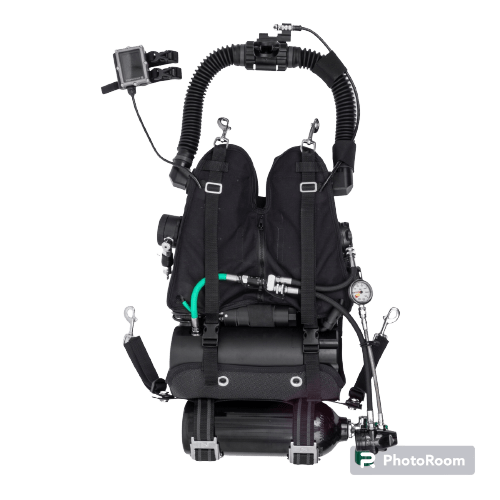
These parameters were achieved in a rugged and durable package with the smallest profile possible.
Dive Rite has committed to ensuring it is one of the most reliable, capable, and high-performing rebreathers on the market. The O2ptima design continues to evolve as units are tested, refinements are made, and new technology becomes available. We are certain that this unit will provide you with many unforgettable hours exploring your underwater world.
The O2ptima CM breathing loop is one of the shortest of any rebreather on the market. 12-inch (30 cm) loop hoses come standard, with 10-inch (25 cm) hoses available for an improved fit on smaller divers. The hose diameter and lengths have been specifically chosen to provide the best balance of comfort and low work of breathing.
Technical specs of the O2ptima CM rebreather:
- Proudly made in the USA.
- Fully electronically controlled closed circuit rebreather (eCCR).
- Redundant Shearwater DiveCAN electronics (Heads-Up Display (HUD) and Petrel 3 controller (NERD controller is optional).
- Water traps inside of the counterlungs and the scrubber end cap.
- Scrubber: Unique scrubber design fully compatible with the ExtendAir CO2 Absorbent Cartridge is also packable with about five pounds (2.2 kg) of granular absorbent.
- Weight: 14.4 pounds (without oxygen cylinder or scrubber material).
- SuperFabric® soft cover for abrasion protection.
- Compact Dive Rite DSV (Dive Surface Valve).
- Oxygen MAV (Manual Add Valve).
- Diluent combination ADV/MAV (Automatic Diluent Valve/Manual Add Valve).
- Four AI R22 oxygen sensors.
- Compatible with any harness with two high shoulder D-rings and 2 waist D-rings.
- Compatible Cylinders (not included): AL 13 (recommended), AL 20, AA LP 13.
Find out more about the O2ptima CM: https://www.diverite.com/products/o2ptima/o2ptima-cm/
Triton
The light and chest-mounted TRITON is clipped onto your harness and connected to your twinset for a more engaged dive. These tanks serve as diluent and bail-out tanks. A small 1.5 L / 12 cuft aluminum tank supplies the TRITON with oxygen.
This configuration improves safety and opens up dive duration and redundancy possibilities.
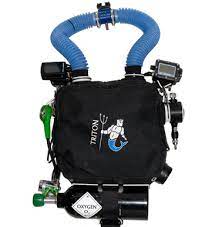
The TRITON is designed to optimize all your dives from 0 to 100 m.
The TRITON has extended beyond recreational and technical diving due to its acquired expertise and is now being used in professional and military environments.
The manufacturer advocates the « Made in France » which has led them to partner and collaborate with several French companies specializing in their respective fields.
Find out more about the TRITON: https://www.multi-3s.com/
Proteus Sidemount rebreather
The Proteus technical sidemount specification is an innovative, yet versatile rebreather package that offers sidemount divers more configuration options than any other rebreather in the marketplace.
There are forty (40) Proteus Technical side mount rebreather specification options that allow the diver to setup the Proteus with a wide range of optional parts. These include individual or dual umbilical gas addition blocks, or an integrated dual gas addition block, which can also have a CMF oxygen (leaky valve). Also, the BOV becomes an option to the standard DSV.
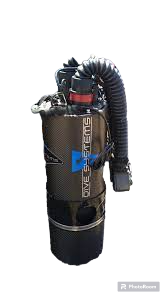
And when the time comes to consider progressing to the next level in your rebreather diving, you don’t have to worry about selling your old unit and buying a new one. Proteus is upgradeable. All you need to do is send your Proteus back to your nearest service center, we’ll do the upgrade, and your instructor will take you through the next training course. Simple.
Find out more about the Proteus: https://divesystems.co.uk/products/technical
SMS 200 Sidemount Rebreather
The SMS 200 Rebreather is a complete on-board gas supplied side mount Rebreather.
All components are stored in an extremely robust CFK tube. The system can be used on the left or the right side.
The basic model is as easy to handle as the CCR KISS system.
The SMS 200 is expandable to a full electronic eCCR system.
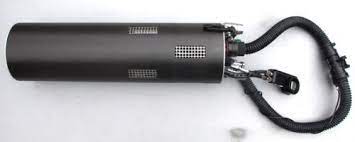
Technical specs of the SMS 200 Rebreather:
- On board Gas supplies: 1 Litre DILUENT cylinder and 1 Litre O2 Cylinder
- Pressure reducer with pressure gauges
- 1 x Oxyscan 100 PPO2 Monitoring
- O2 Booster with adjustable needle valve
- Exhale bag with 6 liter moved the volume and overpressure valve
- scrubber cartridge: 2.5 Kg Absorbent material
- Multihead with sensor chamber for max four sensors
- ADV inside multihead
- breathing loop with Submatix mouthpiece
- X Con Connectors
Find out more about the SMS 200: https://www.submatix.com/
Halcyon Sidemount RB80 and RBK
The RB80 is a mechanical, axial scrubber design, and a very intuitive rebreather unit that is keyed to the diver’s respiration. The gas addition occurs when gas vented from the counter lung forces the actuation of downstream regulator valves. Two downstream valves provide redundancy in the event of a regulator failure. Both valves operate simultaneously. The breathing loop automatically removes the water through a well-designed water trap system.
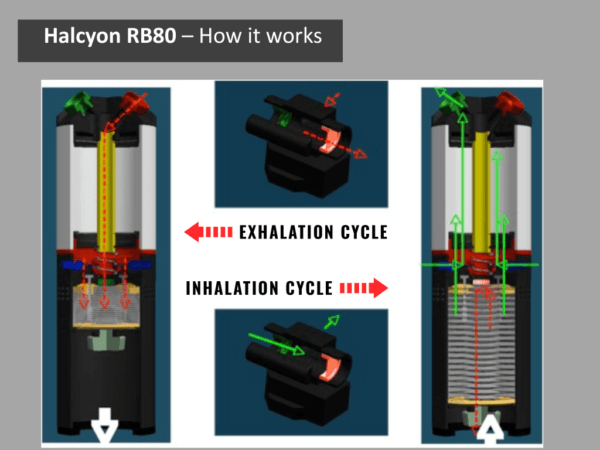
Technical specs of Halcyon Sidemount RB80 and RBK
- scrubber: 5.6lbs (2.54kg) (approximately eight hours)
- 8:1 ratio provides substantial gas extension
- Patent-pending water removal system automatically vents water from the loop
- Semi-closed operation greatly reduces the risk of unit-induced oxygen toxicity while using gases within gas-acceptable limits
- Unique design allows full access to on-board gas supply in either semi-closed circuit or open circuit modes for maximum flexibility (back-mounted version)
- Cylinders and Valves, Manifold, Stand, Regulators, Wing, Backplate, Switchblock, BOV, and loop hoses are sold separately
Find out more about the RB80 PSCR: https://www.halcyon.net/rb80,473,en
Halcyon Symbios Chest Mount Rebreather
The preview was presented in an article of In Depth Magazine
SCUBA DIVING AGENCIES DEEP DARK DIVING PROUDLY REPRESENTS
DEEP DARK DIVING ON SOCIAL MEDIAS
Did we miss something? Leave us a comment.
